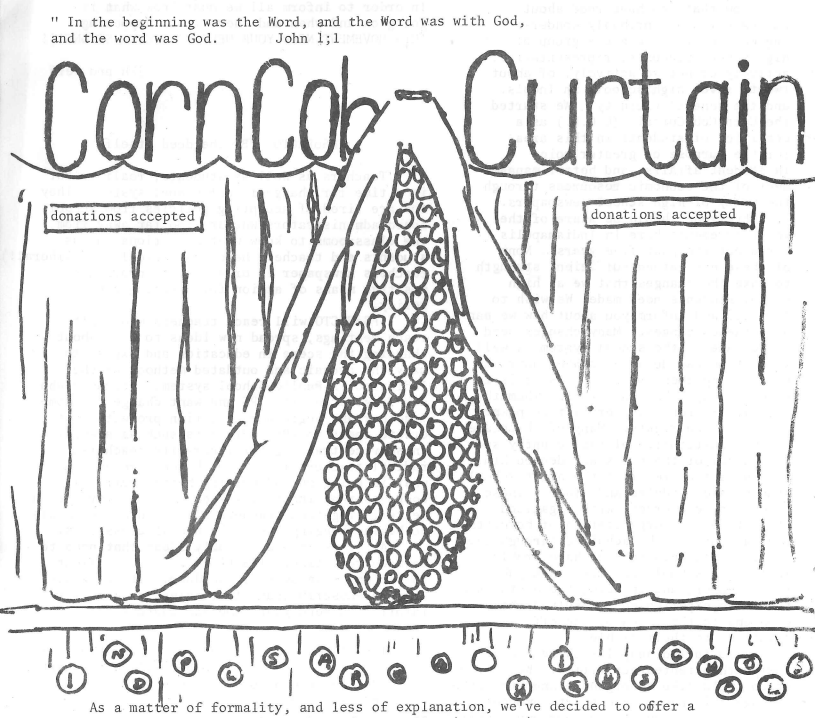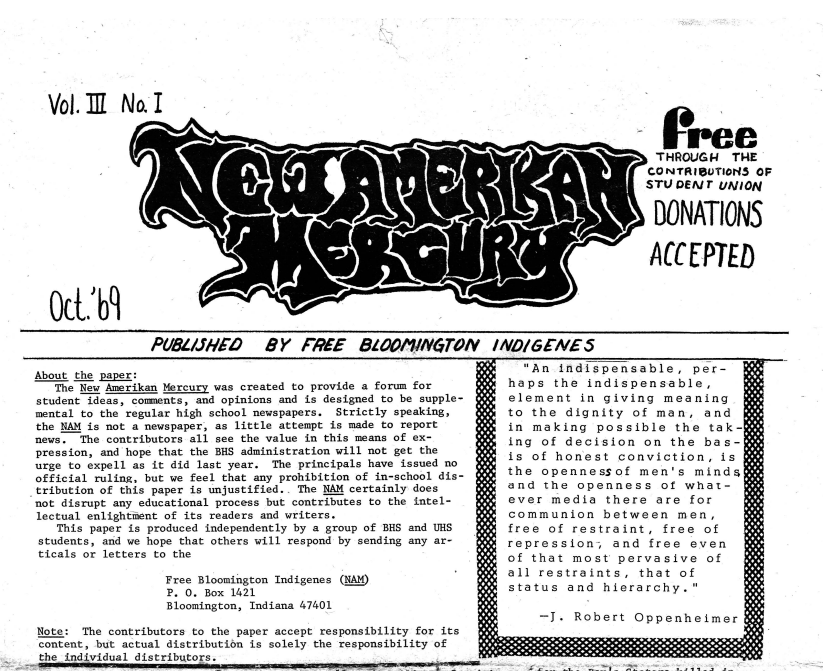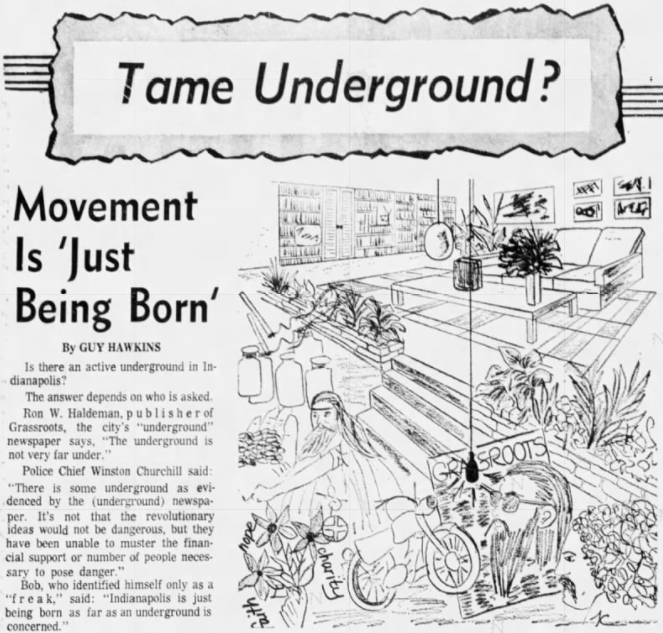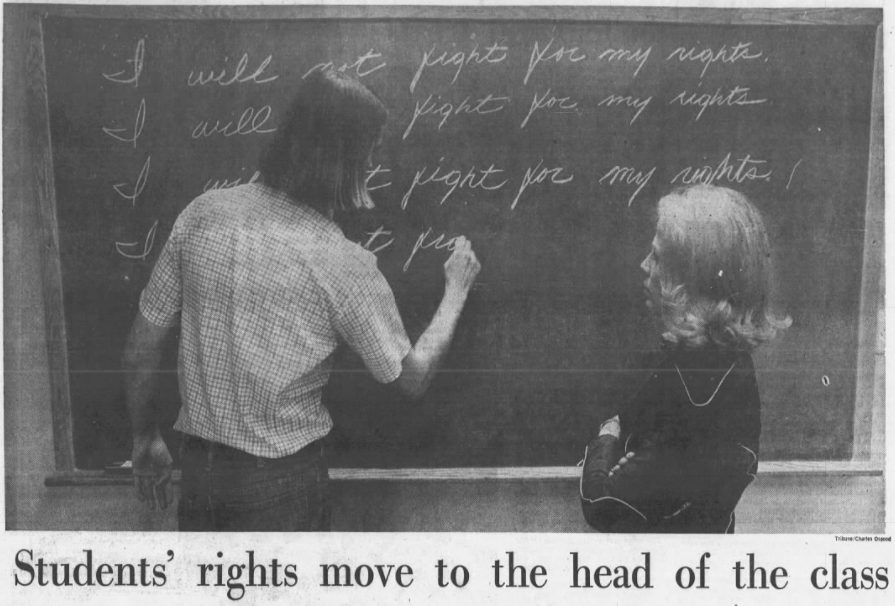
Marty Laubach was an unlikely political radical. Born in Indianapolis, Indiana, his working-class Republican parents attended a church with members of the ultraconservative John Birch Society. But several concurrent events placed him at odds with his parent’s conservative values. The 1968 riots at the Democratic National Convention, the possibility of conscription into Vietnam, the 1970 shooting of antiwar demonstrators at Kent State University by National Guardsmen, and his older brother’s antiwar views solidified his youthful rebellion. He began attending antiwar demonstrations and started working on an unauthorized publication at Arsenal Technical High School called After Breakfast. The publication, which had a short duration, ceased in 1971, so Laubach and a group of like-minded peers created a new underground newspaper called the Corn Cob Curtain.[1] The paper’s countercultural tone and opposition to school policies about unauthorized publications on campus led students to file a lawsuit that went all the way up to the U.S. Supreme Court in 1974.[2]
The Corn Cob Curtain controversy launched the conservative city of Indianapolis and high school students into a battle of free speech. Besides old newspaper clippings, there is no public recognition of the conflict. At its peak, the paper printed around 3,000 copies of a single issue, circulated in over 15 public and private Indianapolis high schools and the surrounding suburbs.[3] It received criticism from school administrators, legal officials, concerned residents who submitted letters to the editors, and the city’s two major newspapers, the Indianapolis Star and the Indianapolis News.
Laubach and his peers were not alone in their efforts in challenging high school’s censorship policies. From mid-1960s to the mid-1970s, a minority of Indiana high school students published and distributed underground publications. Laced with creative drawings, designs, and witty language, they bared the names Blackhawk Broadcast, Desiderata, and the purposely-misspelled New Amerikan Mercury. Constituting a minority of contributors, these publications emerged in urban and rural areas and raised poignant questions about local issues, race, education, and free speech rights.[4] Students remained either indifferent, hostile, or supportive. School administrators balked at their existence and contributors risked retaliation from school officials.[5] Indiana State Treasurer, most notably, referred to them as “trash so foul as to be beyond normal belief” and claimed they were “flooding” high school and college campuses throughout the state.[6]

One contributor, Jeff Jacobs, recalled his experience dealing with hostile school officials while trying to distribute the paper. Although he found Arsenal Tech and Crispus Attucks High School campuses welcoming, he faced resistance at Southport and Emmerich Manual High Schools. At Manual High, school officials threatened to call the Marion County sheriff. “These little skirmishes, with our oppressors should not discourage us, but should enlighten us to try that much harder,” he told readers. “One of the greatest reasons for the CCC’s exisstance [sic] is to equalize the student with the administrators.”[7]
Within this atmosphere, the Corn Cob Curtain was born in 1971. Using pre-established social networks, activists met teenagers from other schools throughout the summer, forming a citywide underground newspaper. The witty name originated from two Cold War metaphors—the “Iron Curtain” and the “Bamboo Curtain”—that alluded to geopolitical divisions between communist and non-communist countries in Europe and Asia. Adapting these metaphors, the students argued that their fight for constitutional rights on campus grounds was akin to the ideological battle “between the Free world and the Communist world.” They found themselves “locked behind a kind of ‘curtain’ of Midwestern Provincialism—a curtain of corn cobs.”[8]
The publication covered a multitude of topics. National and local news stories, American history, student affairs, education, music, movies, book reviews, and cartoons all appeared in the pages. Students critiqued their schools, with one contributor writing “All students in the Indianapolis area attending one of the prisons we call high school,” one written claimed. They insisted “high schools are de-humanizing,” and called for the formation of a citywide student union to “raise an effective voice to start the machinery in motions to bring about these changes.”[9] But no such group ever formed.
Generating public support for the newspaper was an arduous task at first. Some students had reportedly claimed the paper “eats shit.” But these complaints had legitimacy. The first two issues were aesthetically unappealing, images were scarce, stories lacked headlines, and the publication was printed on mimeograph paper. The students improved the paper substantially by printing it on newspaper print, incorporating images, and overall, made it look like an actual newspaper. In the third issue, publishers wrote an article titled “On Your Ass” and lambasted students’ lackluster participation and demanded action on their part to improve the paper’s shortcomings. “You, your paper, need to criticize what’s wrong with the Cob, if you don’t like it. You are the only one who can change it,” they exclaimed. If anything, the students wanted their peers to know that the Corn Cob Curtain was a collective effort, not just the responsibility from a small group of volunteers.[10]

The Corn Cob Curtain controversy began after the district Superintendent banned the publication upon the fifth issue’s release. Administrators’ justification for the ban stemmed from a cartoon that appeared on the back page. In a cartoon series called George the Cat, the character George wires up some dynamite in a bathroom while expressing dissatisfaction with the school. Just as he lights the fuse, the principal walks into the restroom, leading George to frantically jump into the toilet. As the principal begins using the restroom the toilet explodes. George survives the explosion with bruises, a broken arm, and human feces on his head. He quips, “I may have gotten rid of the school, but I’m still eatin’ the principals’ shit.” What was intended as a joke infuriated school officials who viewed the entire publication as obscene and wanted it discarded. The district’s attorneys agreed. They cited the cartoon as advocating “violence and the destruction and the school and the murder of the principal.” This gave school officials fodder to justify banning the paper.[11]
Laubach and five friends sought legal assistance from Craig Pinkus of the American Civil Liberties Union of Indiana and Ronald Elberger of the Legal Service Organization (LSO). Both young lawyers, Pinkus and Elberger agreed to represent the students. As a publicly funded organization that represented low-income families in Marion County, the LSO received criticism for representing what the local press dismissed as privilege, middle-class youth. Although this description wasn’t entirely accurate, it never halted the conservative editorial board of the Indianapolis Star from alleging the group was seeking to “destroy the power of Indianapolis school officials to ban a smutty underground paper from high school.”[12]
The federal district court ruled in the students’ favor, as did the U.S. Court of Appeals, citing that school officials had failed to show the detrimental effects the publication had on young people. Emboldened by calls to appeal the case by the Indianapolis Star and Indianapolis News after the district court ruling, the school district appealed the case all the way up to the U.S. Supreme Court in 1974.[13] The oral arguments delivered by the school district’s attorney to Supreme Court justices revealed that school officials viewed the issue as a power struggle.

Attorney Lila Young insisted the district had “a complete inability to have any rules or regulations of what is going to be distrusted in our schools.” She constantly referred to the Corn Cob Curtain as “filth,” and alleged it contained “filthy cartoons” and “gutter language.” She argued that the distribution of such material contributed “to the delinquency of minors.” The students’ lawyer, Craig Pinkus, juxtaposed the publication to other material students read in schools that also continued inappropriate language, such as the New York Times, Wall Street Journal, and Catcher in the Rye. But the justices continuously asked him whether the policy applied to elementary schools, and Pinkus stated his organization drew a line between primary and secondary schools.[14]
Since the students did not file a class-action lawsuit, Supreme Court justices ruled the case moot in February 1975. Additionally, the publication no longer existed, partly because the plaintiffs had graduated from high school. The court remanded the case back to the lower court. Justice William O. Douglass wrote a dissenting opinion about the mootness of the case. He believed clashes would continue between students and administrators and the issue might appear in court again.[15] But his prophesy never came to fruition in Indianapolis. Interestingly, no consensus emerged for what the ruling meant. The ACLU argued that students’ rights to distribute an unauthorized publication on campus had not been overturned while the Indianapolis Star viewed the ruling as a victory for the school district, but acknowledged its inconclusiveness. Nonetheless, by 1975 high school underground newspapers were no longer a topic of contention in Indiana.[16]
The Corn Cob Curtain controversy represented the clash of counterculture and conservative politics in a city impacted by the social upheaval of the 1960s much later than other major urban areas. Tame compared to locations such as the San Francisco Bay area, Chicago, and New York, it took little to be declared a radical by city and school officials in Indianapolis. Indianapolis’s high school students infrequently participated in strikes. Instead, they created a citywide student protest movement through an underground newspaper and built a growing, radical political consciousness in the process.
Notes:
[1] Martin Laubach, interview with author, June 9, 2017, Bloomington, Indiana.
[2] Aaron G. Fountain, Jr., “Building a Student Movement in Naptown: The Corn Cob Curtain Controversy, Free Speech, and 1960s and 1970s High School Activism in Indianapolis,” Indiana Magazine of History 114, no. 3 (September 2018): 202-237.
[3] Oral Arguments, Board of School Commissioners of the City of Indianapolis v. Jacobs, December 11, 1974, accessed Oyez.org.
[4] Diane Divoky, How Old Will You Be in 1984?: Expressions of Student Outrage from the High School Free Press (New York: Avon Books, 1969), ix.
[5] Fountain Jr., “Building a Student Movement in Naptown,” 209.; “W.G.U. Responds to Criticism,” Warren Owl (Warren Central High School), December 10, 1971, Warren Central High School Archives, Indianapolis, Ind.
[6] “Snyder Hails Tax Feat of Legislature,” Indianapolis Star, March 26, 1969.
[7] Jeff Jacobs, Corn Cob Curtain 1, no. 3, December 1971, 4, Box 6, Folder 15, Youth Liberation Press Records.
[8] Corn Cob Curtain1, no. 1, [1971?], copy in author’s possession, used with permission by Deborah Owen.
[9] “Jail Break,” Corn Cob Curtain, 1, no. 5, [1972?], 5, Box 6, Folder 15, Youth Liberation Press Records, SCRC 175, Special Collections Research Center, Temple University Libraries, Philadelphia, Pennsylvania.
[10] “On Your Ass,” Corn Cob Curtain, 1, no. 3, December 1971, Box 6, Folder 15, Youth Liberation Press Records.
[11] Ibid., 223; “Underground Paper ‘Guidelines’ Sought,” Indianapolis Star, September 29, 1972.
[12] Fountain Jr., “Building a Student Movement in Naptown,” 223-224.; “Funds for Radicalism?” Indianapolis Star, October 20, 1972.
[13] Fountain, Jr., “Building a Student Movement in Naptown,” 230-231.
[14] Oral Arguments, Board of School Commissioners of the City of Indianapolis v. Jacobs, December 11, 1974, accessed Oyez.org..
[15] Jacobs v. The Board of School Commissioners, 1975, U.S. Supreme Court. LEXIS 30.
[16] Fountain, Jr., “Building a Student Movement in Naptown,” 232-234.
